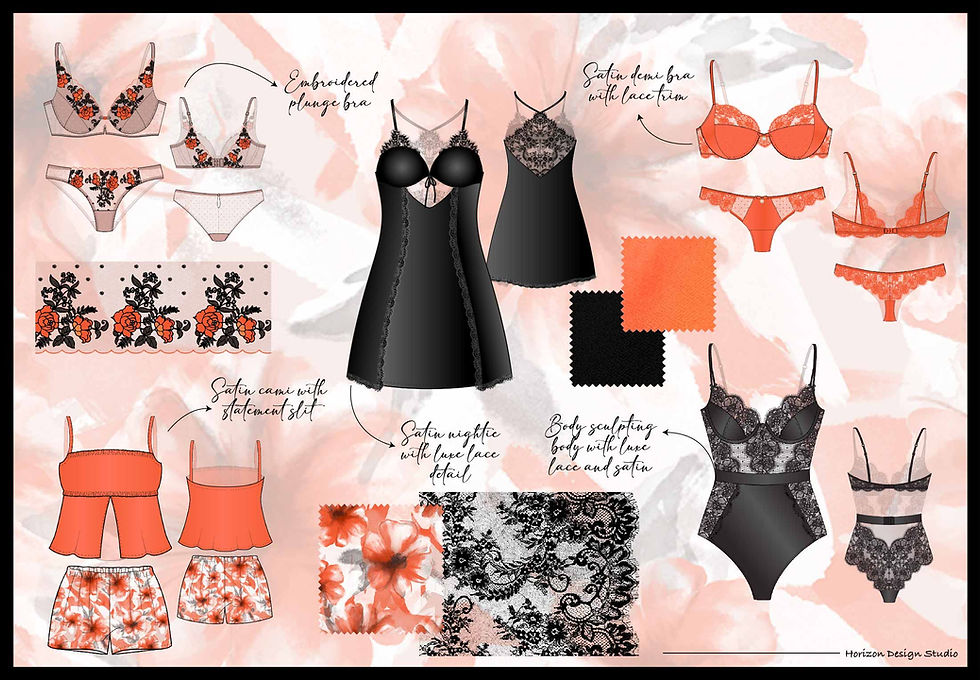Spot Trends & Find Gaps: A Startup Lingerie Brand’s Guide
- Ash Rema
- Jul 8
- 4 min read

Starting a lingerie or swimwear brand is exciting, but overwhelming! Especially when the market is constantly shifting.What trends should you follow? How do you stand out? And how can you launch with confidence, knowing you’re not just designing a beautiful product, but one your customer actually wants?
After working with major fashion retailers and emerging brands for over 15 years, I’ve developed a reliable process to help founders spot trends early, identify market gaps, and launch with purpose.
This blog post breaks it down into a simple, practical guide.
✨ Start with Understanding How Trends Work
Most trends don’t appear out of thin air. They are shaped by macro shifts, think climate change, global events, political shifts, economic pressures, or evolving cultural behaviours. These macro shifts influence how people live, shop, and dress. Eventually, they trickle down into micro trends, like colour palettes, silhouettes, or fabric choices in lingerie and swimwear.
As a brand founder, if you can tune into the why behind a trend, you can start predicting what’s next, instead of reacting too late.
✨ Step-by-Step: How to Spot Trends Before Your Competitors
1. Look Back Before You Look Ahead
Ask:
What were the strongest lingerie or swimwear trends from the last 2-3 seasons?
Which ones are evolving? Which ones disappeared?
Fashion rarely changes overnight. Trends often build slowly. By identifying patterns and evolutions, you can spot what’s continuing and what might be on its way out.
2. Follow the Right Designers, And Read Between the Lines
Not every runway show is relevant for lingerie and swimwear. Focus on designers known for feminine, detailed, or layered aesthetics like Chloé, Dior, Dolce & Gabbana, Zimmermann, and Valentino.
Watch for:
Sheer layering
Corsetry and structured seams
New colour stories
Swimwear textures appearing in outerwear
If the same ideas show up in multiple collections, it’s a trend in the making.
3. Analyse Fabrics, Colours, and Silhouettes
Ask yourself:
Are the fabrics structured, fluid, or sheer?
Are we seeing pastels, jewel tones, or unexpected brights?
Are high-waisted silhouettes fading or still strong?
These details often hint at what will show up next in lingerie and swimwear, but in a softer, more wearable form.
4. Understand Your Customer’s Local Reality
As someone who has worked across Europe, the Middle East and Asia, I can confidently say:
One trend does not fit all.
Climate, modesty, lifestyle, all impact what customers will actually wear. That’s why you need to ask:
Can this trend be adapted for my customer?
Will they feel confident and comfortable wearing it?
Is the fabric suited to their local weather?
Take colour, for example. We now see lime and lavender in winter and burgundy in summer, a response to unpredictable weather patterns and the need for longer product shelf lives. Smart brands are building flexible colour stories that work year-round.
5. Be Curious About Culture
Some of the strongest trend shifts come from culture, not catwalks.
I once worked on kids’ sleepwear where gaming graphics suddenly exploded. At first, we assumed it was because of lockdowns. Later, I realised it was tied to the rise of live-streamed gaming, and how Gen Z and Gen Alpha were embracing that identity across fashion, slang and humour.
If I had caught that early, I would have designed slogan sleepwear that tapped into that language and vibe.
Ask yourself:
What’s trending on social media in my niche?
How are my customers talking, living, feeling?
What’s changing in their day-to-day life?
🔍 How to Spot Market Gaps (And Fill Them Strategically)
Once you’ve spotted a trend, the next question is: Is there a market gap I can fill?
Here’s how to approach it:
✅ Ask the Right Questions
What need is not being met in my category?
Are customers asking for something that’s hard to find?
Can I make something better, more inclusive, or more sustainable?
✅ Test Small, Scale Smart
Run small tests. As a rule, I recommend testing with less than 10% of your usual collection.If you're in retail, offer it in top-performing stores.If you're online, give it a feature spot so it doesn’t get lost.
If it performs well, scale it quickly, you already have the prototype and sourcing plan ready.
📌 Before You Start: A Self-Check for Founders
Here’s a quick checklist to evaluate if a trend or product idea is right for your brand:
Does it solve a real problem for my customer?
Can I explain why this product makes sense for them right now?
Do I have enough references (visual or written) to brief a designer clearly?
Am I willing to test and learn before going all in?
Is this aligned with my brand values, tone and identity?
💡 Want to Save This Guide?
👉 Download your free checklist here:
💬 Final Takeaway
You don’t need to guess what to design. You just need to observe carefully, ask smart questions, and adapt with confidence.
Great design doesn’t chase trends blindly. It understands the why behind them and turns that insight into product ideas that stick.
If you’d like curated support in developing your next collection, with strategy, commercial focus and trend alignment, book your free discovery call.
--------------------------------------------------
✍️
I’m Ash, founder of Horizon Design Studio, and I specialise in creating bespoke lingerie, swimwear and loungewear designs that reflect today’s market values.Let’s build something meaningful.





Comments